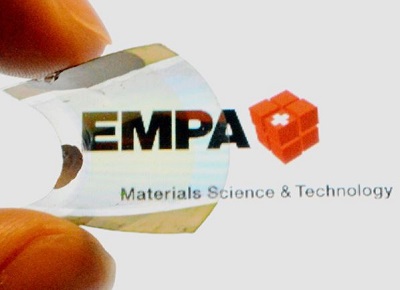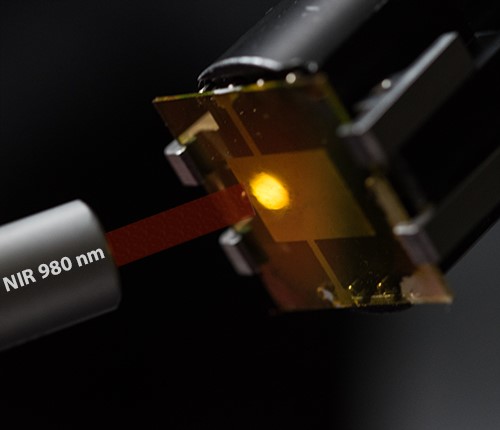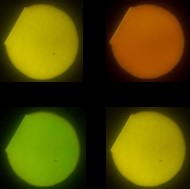Structured Organic Films for Functional Devices
The synthetic tunability and facile deposition of semiconducting small molecules and polymers is being exploited in various commercial organic optoelectronic devices, and is a nascent field of research for next-generation applications in sensing, bioelectronics, or energy storage and conversion. Within this field of research, we design and synthesize organic salt semiconductors for the development of optoelectronic devices with an added value. Organic salt semiconductors are interesting due to their tunable and very narrow absorption bandwidth, their ability to self-organize into low-dimensional nanostructures, and the presence of mobile ionic charge, whose controlled arrangement at junctions can be used to control the flow of electronic current. We exploit these properties for the development of visibly transparent solar cells and photodetectors, optical upconversion devices and light-emitting electrochemical cells.
Visibly Transparent Organic Optoelectronic Devices

Combining organic semiconductors with discrete absorption and emission bands outside the visible wavelength range with transparent and conductive electrodes allows for the fabrication of visibly transparent organic electronics. We design and synthesize selective near-infrared absorbing polymethine dyes (cyanines, squaraines), aiming at dyes that absorb beyond the silicon band edge. Together with transparent and conductive electrodes that can be deposited on flexible substrates, we fabricate visibly transparent solar cells, photodetectors and image sensors. Such devices enable a manifold of novel and alternative applications in interactive displays, integrated on-glass electronics or power-generating windows.
Poster: Near Infrared Absorbing Cyanine Dyes for Visible Transparent Organic Solar Cells
Optical Upconversion Devices

The growing interest in near-infrared (NIR) imaging is explained by the increasing number of applications in this spectral range, including medical imaging and process monitoring. NIR-to-visible optical upconverters consist of a series-connected NIR photodetector with a visible light-emitting unit. Such devices convert NIR light directly to visible light and allow capturing a NIR image with an ordinary camera. Optical upconverters have emerged as an attractive low-cost addition to the current technology based on inorganic semiconductor photodiode arrays interconnected with read-out integrated circuitry. We develop new materials and device concepts for all-organic upconverters, focussing on flexible and large-area solution-processed devices, narrowband NIR imaging as well as highly sensitive upconverters with a gain.
Poster: Transparent organic infrared upconversion device with sensitivity beyond 1000 nm
Poster: All-solution-processed infrared to visible organic upconversion device
Poster: Making the invisible visible using cyanine J-aggregate comprising upconversion devices
Mixed Electronic/Ionic Conduction

The simultaneous occurrence of electronic and mobile ionic charge in organic materials has numerous applications in technologies ranging from organic electrochemical transistors to batteries, actuators, sensors and displays. In light-emitting electrochemical cells (LECs), a single solution-processed emissive layer that contains a salt is sandwiched between two air-stable electrodes. The LEC device concept sounds simple, but in truth it’s not easy at all; despite twenty-five years of research, resolving the intricate interplay between electronic and ionic charges that governs the LEC operating mode presents a considerable scientific challenge. We use a combined experimental with optical/electrical simulation approach to study sandwich LECs, with a focus on improving the device efficiency and long-term stability, resolving the developing doping and ion gradient towards the charge recombination zone, and understanding the often observed temporal shift of the emission zone during operation.
Poster: Cyanine dye ionic junctions for organic electronics
Poster: Assessing ion redistribution in thin film light-emitting electrochemical cells
-
Share
